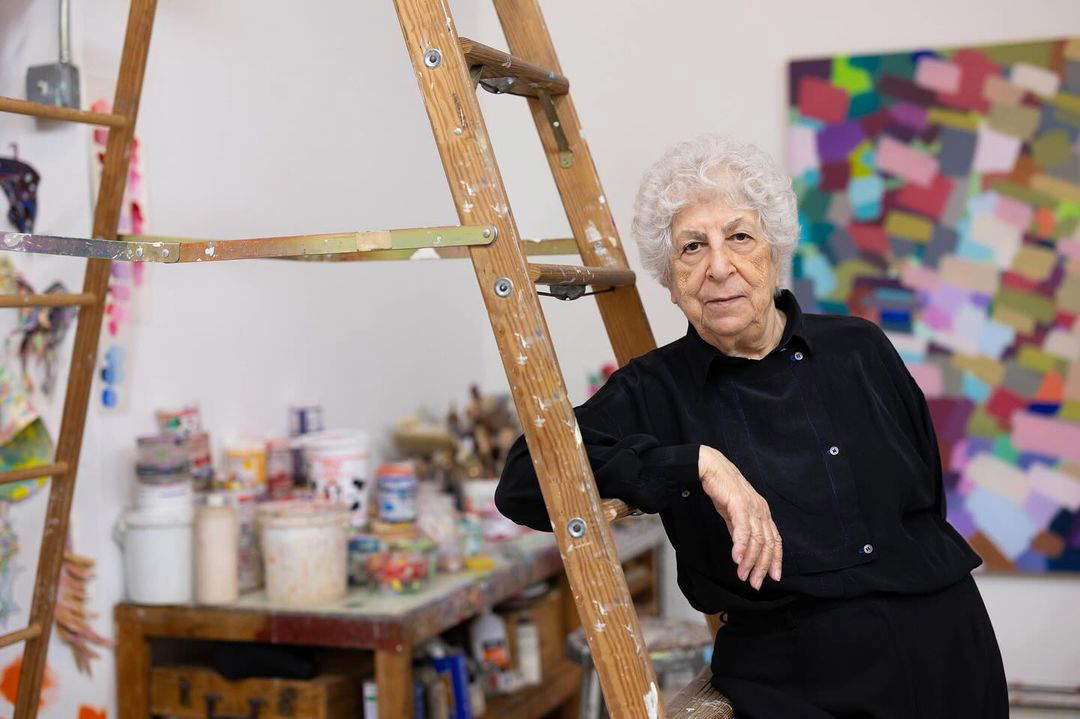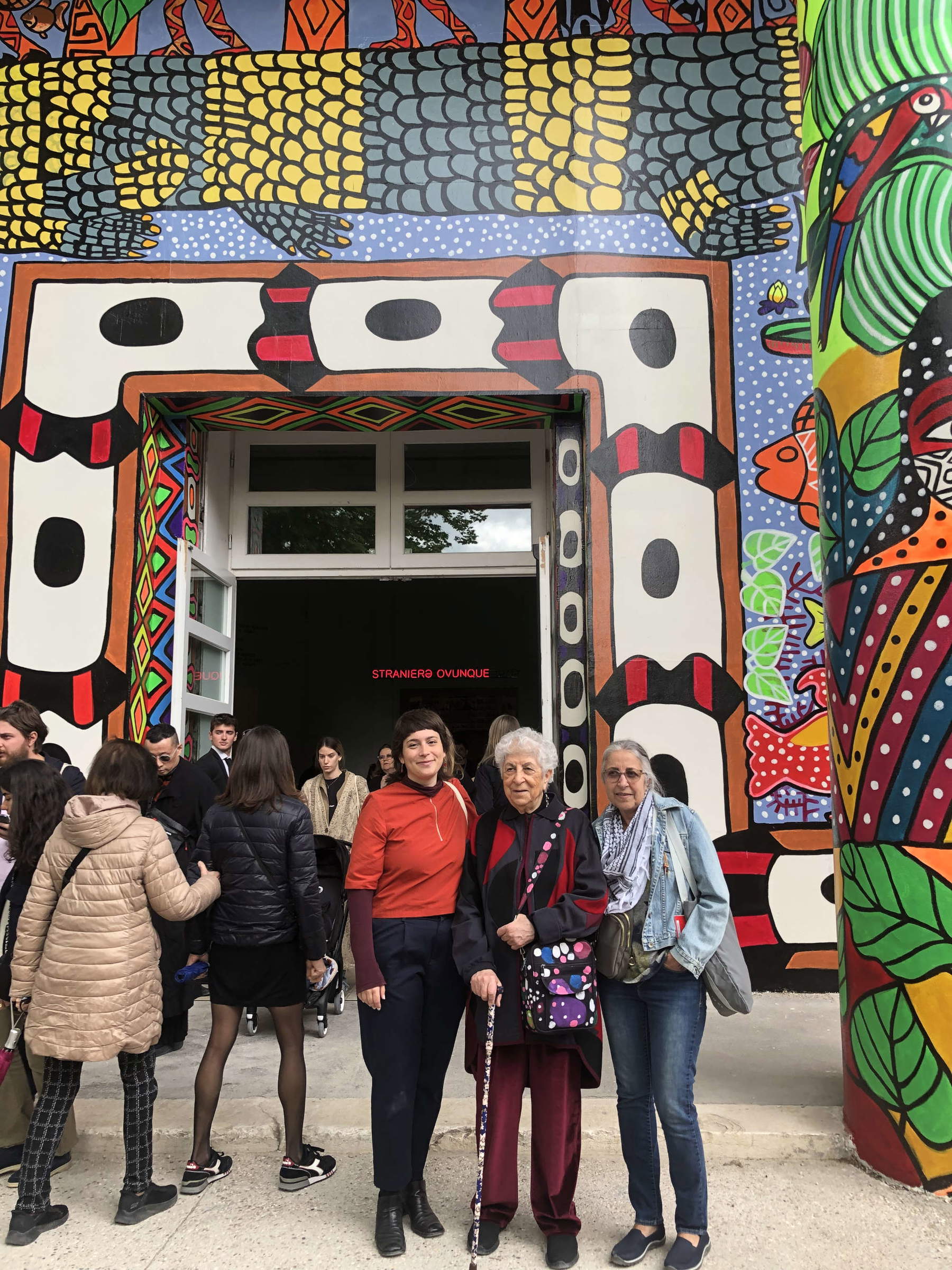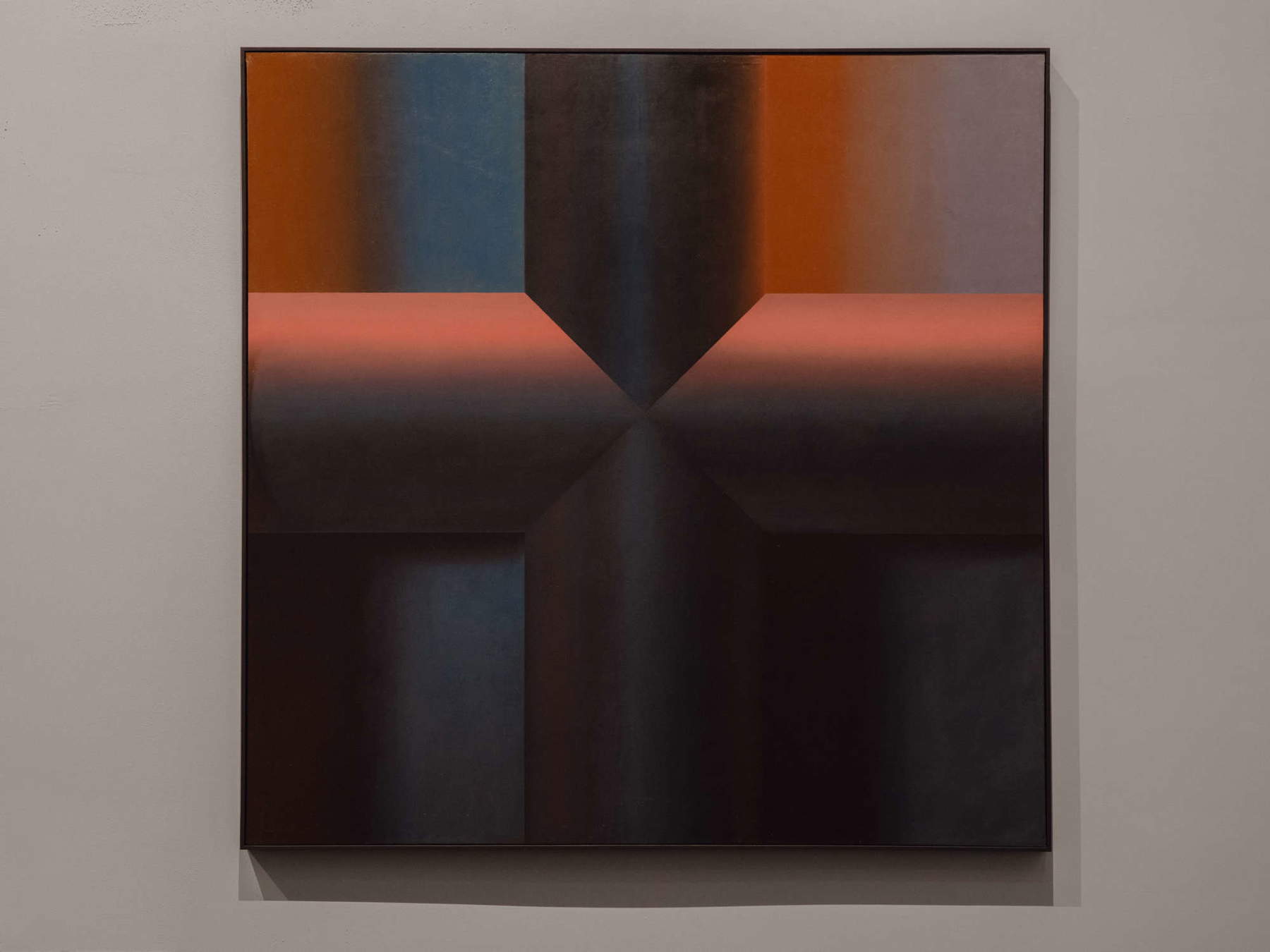Biennale award-winning artist speaks: 'Palestine and statelessness without pavilions? The Biennale's statute should be changed."
Samia Halaby (Jerusalem, 1936) is the only Palestinian artist in the main exhibition of the Venice Art Biennale. Her 1969 painting Black is Beautiful, a tube crucifix that cites Optical Art but could just as well be an enlargement of a detail of Fernand Léger’s paintings, is displayed in the room devoted to international abstract art in the Central Pavilion, Historical Core section. Another artist of Palestinian origin, Dana Awartani, figures instead in the Arsenale with a textile installation and with a composition that is always very abstract and that overall, because of the play of transparencies and orange hues, is reminiscent of Rothko. Halaby was awarded a Special Mention by the Venice Biennale jury during the official awards ceremony on April 20. Halaby’s activism is as subtle in her painting as it is determined in her live responses, and she is not among those correcting her pitch after the award ceremony. She approved this interview, recorded a few days before the Biennale awarded her the Jury’s Special Mention, without changing a comma. With the war in the Gaza Strip, and at a historical moment when the Israeli government is being scrupulously watched by the International Court, Samia Halaby explains why, without a structural reform of the Venice Biennale, the world’s most coveted and envied exhibition cannot, in her view, claim itself as international.
REF. I saw you in the Giardini della Biennale at the A.N.G.A. group’s protest in front of the Israeli Pavilion. Were you there by chance?
SH. I know the ANGA and I read their statement. I also wrote them a letter of loving critical support. Yesterday I happened to see them and realized that they were demonstrating in front of the Israeli Pavilion. Naturally, I joined them.
What do you think about the Israeli Pavilion and the decision to partially close it this year? As everyone could see, the Israeli Pavilion, although closed, is all glass and the Israeli artist’s video is projected on a loop so that you can still watch it from the outside.
I didn’t read their statement about why they “closed,” but it was pretty obvious, since the Israeli government is doing so many horrible things, that the Israeli Pavilion team would have to answer questions and would be under close scrutiny. It was a political move on their part. They chose to defend the Israeli government’s lies with silence. They ran away and we should continue to let them run away.
So you don’t think they were sincere?
Of course not! There is no sincerity in that, because the official demand is the same as they have been doing all along but the Israeli government keeps shooting and killing, so their sincerity must be questioned by anyone with any common sense. Those who believe and support them are like-minded people.
What do you think of the Venice Biennale’s rejection of the request to establish a Palestinian pavilion?
It is not possible to have a Palestinian pavilion because there is no Palestinian state. The Venice Biennale should have an administration brave enough to invite stateless indigenous peoples to create their own pavilions regardless of the states that oppress them and occupy their lands. Occasionally, the Biennale administration has granted special openings for Palestinians. I know the first time they did that, maybe it was 20 years ago, it was an exhibition that took place between the avenues of the Giardini. It was about a married couple, one was Italian and the other Palestinian. Palestinian participation in the Biennale depends a lot on who the curator is.
Do you check in every edition of the Biennale if Palestinian artists are present?
I am not very interested in the Venice Biennale because there is no hope for Palestinians to participate. Palestine does not have a state, and the Venice Biennale is organized according to state structures. This is a weakness that I hope the Biennale administration will correct.
Do you think it is important for Palestine to have a pavilion?
The current situation is as follows: the Venice Biennale is administered by the Italian state, which chooses other states to exhibit with total curatorial freedom in their own pavilions. This is the model that the Venice Biennale has established. With such a structure of the Venice Biennale, I remain an outsider here and I look at the Venice Biennale as an outsider looks at it. Of course I have the opportunity to see the great cultural variety and learn from it; but I am also aware that many things are missing. I cannot afford the mistake of believing that this exhibition represents world art, nor can I accept that the Venice Biennale is the universal judgment on art. I must remain true to my worldview.

So you don’t feel fully included in this Biennale?
I am not included, I am chosen by a curator. There is a clear difference. It is the curator’s merit. But the Biennale structurally remains the Biennale. And what I’m saying is that if the administration of the Venice Biennale wants more than half of the world’s population to recognize its leadership position, it has to be able to recognize this other half of the world. For now, the Biennale administration only sees things from one point of view: it is a choice that is limiting the learning of everyone, including artists, who come to the Biennale.
Were you surprised to be invited by Adriano Pedrosa?
I am not surprised, my artistic research is very good! And I am not the only one, the world is full of good artists! There are hundreds of thousands of good artists, and the Italians will not be able to see them. The loser is Italy and the West, not me, not us. It is worth thinking about the future and trying to change. One day the West will lose this opportunity.
Is that the message you want to send to Italy?
Italians are a wonderful people with a great history that I love and have studied. I do not consider the attitude of the Biennale as representative of the Italians. It is not about the Italians, they have the same spirit as the Palestinians, they are emotional, they have strong family ties and they welcome us. I am moved by their kind and welcoming support.
Italians and Palestinians remain Mediterranean, can you say you feel a little at home in Italy?
Yes, I feel at home in Italy, but the Venice Biennale has never been a potential home for me. I came twice before this year to observe and learn.
So you came to see previous editions before this one.
Yes, because I like art and I like Italian History.
When was the last time you came to Italy?
I came for a conference called “Venice Biennale Arab World,” I wrote a paper on my personal theory of art history that I had to rewrite because art teaching is still very limited and Eurocentric. For example, when I was in college studying art history, our textbook was titled “World Art History” and it was almost a thousand pages. Well out of those thousand pages, the Asian continent from prehistory to the present had about only ten pages.
Is that what you talked about at the conference?
This is what I just told you: the teaching of art history is distorted, and many of us have seen that. This should be embarrassing to the administrators of the Venice Biennale who quietly set up an Israeli pavilion while Israel is committing genocide against the Palestinians. They have not taken the slightest interest in Palestinian art or considered the possibilities. Let me give you an example: as soon as the genocide started, the Palestinian Museum in the West Bank created a huge exhibition of paintings from Gaza. It was a selection of paintings owned by people living or living in Jerusalem, Ramallah and all over the West Bank, people who loved art, bought it and hung it in their homes. This exhibition should be invited here, should come here to replace the Israeli pavilion. It would teach the world the spirit of the Palestinian “sumoud,” the indelible will to live and be free. This would place the Venice Biennale in a remarkable position in history. To have the courage to tell the world, “here, look at what oppressed peoples, who have been suffering genocide and oppression for over seventy-five years, still manage to create with love.” I call on the organizers of the 60th Venice Biennale to replace the Israeli pavilion with paintings from Gaza without setting quality standards. Respect the public’s right to see and judge. The situation is surprising. Do not neglect one of the great events of our time.

Would you like to mention Palestinian artists you would like to see here in particular?
There is a wonderful work, One Hundred and Forty Days, running in the Beyond Boundaries exhibition here in Venice, by an artist from Gaza called Maisara Baroud. It is a wonderful diary of powerful drawings made by the artist every day, of what she has seen and experienced during the genocide, from the murder of children to the killing of mothers and the press, to starvation, bombings and more.
I’m playing devil’s advocate: some might argue that this is political art.
No, it’s documentary and it’s art to a high standard. You know, the double standards are all familiar to me. Are Goya’s war works political art or are they great art?
Your work exhibited in the Central Pavilion here at the Giardini of the Venice Biennale is an abstract painting. Would you call it documentary or political?
It is not documentary; it is political only in that abstraction is the art of the working class revolution. The first precious steps toward abstraction were evident first in the Impressionists, then in the painting of Soviet artists, then in the Mexican muralists and the American abstract expressionists. This is the path I have chosen. I have a global vision and global responsibility, I have studied art from all over the world, with the same open-mindedness, and I am intellectually capable, so why should I narrow my vision? There is no reason.
Is your research still abstract since you were painting the work shown at the Biennale in the 1960s?
Intuitively this is what is important to me. According to my practice, abstraction is the art of the future. I am still very abstract in my painting, but I also do documentary art and overtly political art like posters and banners.
Do you mean that, compared to abstractionism, figurative art is outdated?
I’m talking about progress. Documentation, political art, posters, cartoons, maps, photography, all these came out of painting. So one has to be careful when speaking generically about each. Doctors still need medical illustrations, and children need to learn from fun materials. From rock art we have evolved, we are moving forward, our drawings have become more and more complex, there are different disciplines. Past achievements have not been lost.
Are you satisfied with Adriano Pedrosa’s installation in the room dedicated to abstract art where your painting Black is Beautiful is displayed?
The Biennale exhibition is huge and I really love the variety, but it could have contained a lot more abstraction. I’m sorry I had to leave early [nda: before the Lions awards ceremony] because my sister was rushed to the hospital. I can only say that Adriano Pedrosa has my admiration for the magnificent work he has done.
Warning: the translation into English of the original Italian article was created using automatic tools. We undertake to review all articles, but we do not guarantee the total absence of inaccuracies in the translation due to the program. You can find the original by clicking on the ITA button. If you find any mistake,please contact us.



























